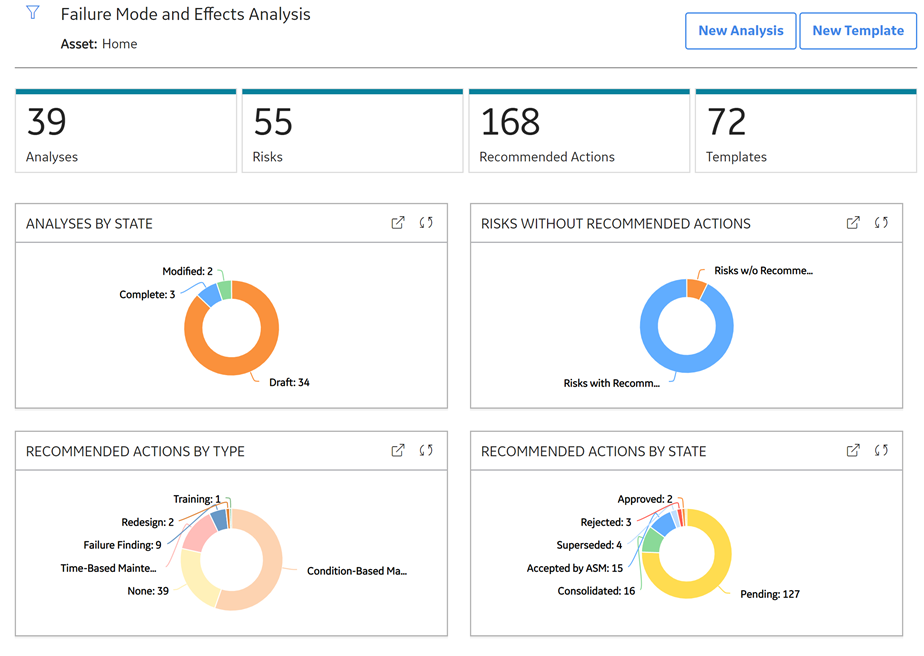Overview
Overview of the Failure Modes and Effects Analysis (FMEA) Module
A Reliability Centered Maintenance (RCM) analysis evaluates a system with respect to its individual function to determine how to avoid functional failures. Failure Modes and Effects Analysis (FMEA) focuses on actual equipment and locations and analyzes how each piece of equipment or location can fail and the effect of each failure. In other words, an RCM Analysis is conducted for the purpose of maintaining the function of a system. An FMEA Analysis is conducted for the purpose of maintaining the system itself.
Specifically, FMEA is a method of identifying the potential failures of equipment and locations, describing the possible effect of each failure, and making recommendations for actions that can be taken to prevent the failures from occurring.
In GE Digital APM, an FMEA Analysis consists of the following components:
- Asset: To create a FMEA analysis, you must define your assets.
- Failure Modes: After you have defined the equipment and locations for an FMEA Analysis, you can define one or more failure modes for each piece of equipment and location. Failure modes describe the ways in which each piece of equipment and location failure is likely to occur and are stored in RCM/FMEA Failure Mode records.
- Failure Effects: For each failure mode, you can then define failure effects, which describe the consequences of a failure occurring. Failure effects might describe the safety, environmental, and economic (or production) impact associated with a failure. In GE Digital APM, you can define a Risk Matrix that will be available in the analysis and can help you define the effects of each failure mode.
- Recommended Actions: For each failure effect, one or more recommended actions can be defined and stored in an RCM/FMEA Recommendation record. A Recommendation record defines what should be done to avoid the risk defined by the Failure Modes and Failure Effects. Recommended Actions can be determined, in part, using the Decision Tree document that has been set up for use with FMEA Analyses.Note: In addition, for each FMEA Analysis, you can define an FMEA team, which is a list of people who are involved in the analysis.
Access the FMEA Overview Page
About This Task
Procedure
The FMEA Overview page appears, displaying the following tabs:
- Analyses: All analyses in the module.
- Risks: All the failure modes and effects associated with the analyses in the module.
- Recommended Actions: All the recommendations associated with the analyses in the module.
- Templates: All templates in the module.
The page contains the following charts:
- Analyses by State: Plots the number of analyses in each state.
- Risks Without Recommended Actions: Plots the number of failure effects in analyses with and without associated recommended actions.
- Recommended Actions by Type: Plots the number of recommended actions of each type in all the analyses.
- Recommended Actions by State: Plots the number of recommended actions in each state in all the analyses.

You can select
 in the page to filter the information displayed on the Failure Modes and Effects Analysis Overview page to a specific time range or asset. When you filter by an asset, the page displays information for the selected asset and the assets under it in the hierarchy. The Home level includes information not related to an asset or related to an asset not in the Asset Hierarchy.
in the page to filter the information displayed on the Failure Modes and Effects Analysis Overview page to a specific time range or asset. When you filter by an asset, the page displays information for the selected asset and the assets under it in the hierarchy. The Home level includes information not related to an asset or related to an asset not in the Asset Hierarchy.
Failure Modes and Effects Analysis (FMEA) Workflow
This workflow provides the basic, high-level steps for using this module. The steps and links in this workflow do not necessarily reference every possible procedure.
- Create FMEA Analysis record.
- Create the Analysis team
- Define the equipment and location list.
- Define failure modes for each equipment or location.
- Define failure effect for each failure mode
- Define Recommended Actions for each failure effect.
GE Digital APM provides various tools that you can use to accomplish these tasks. The tools that you use will depend on your personal preference.